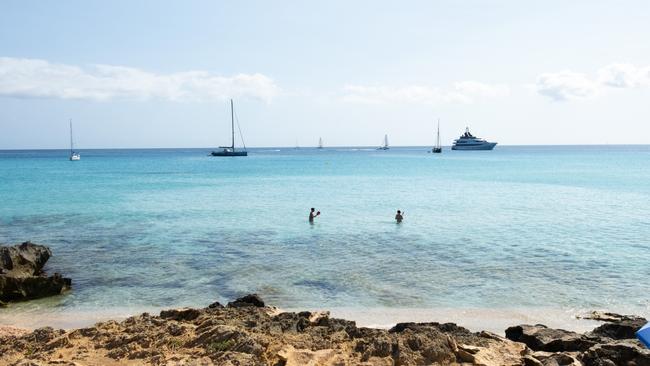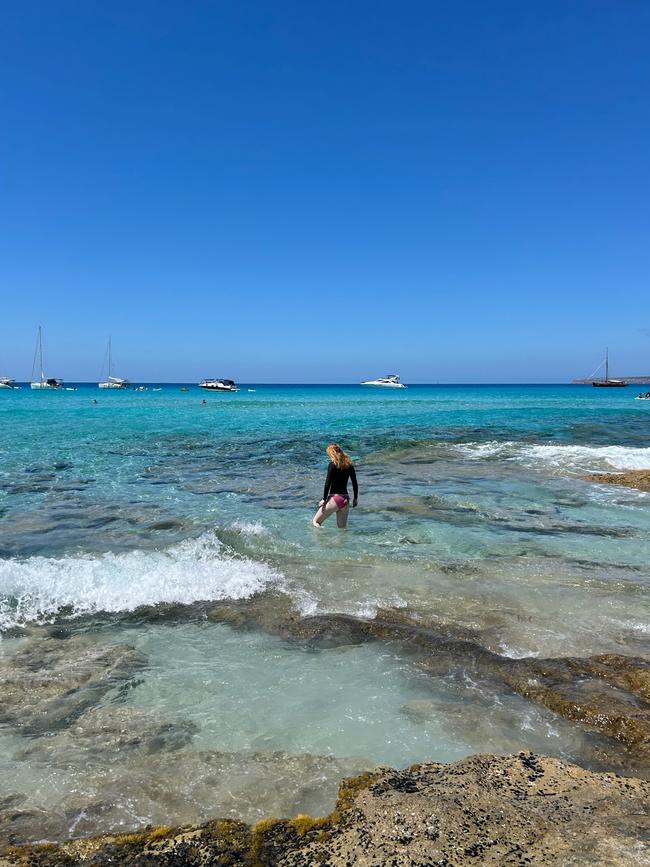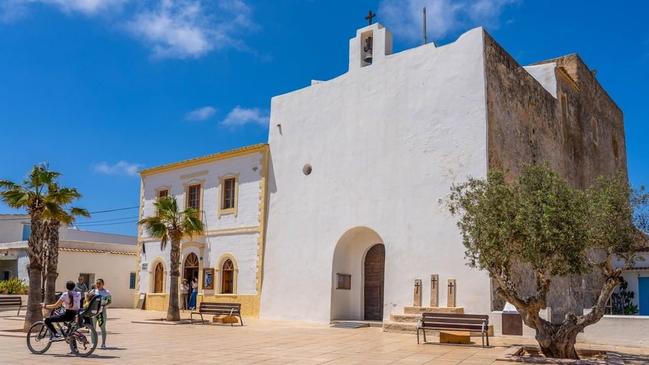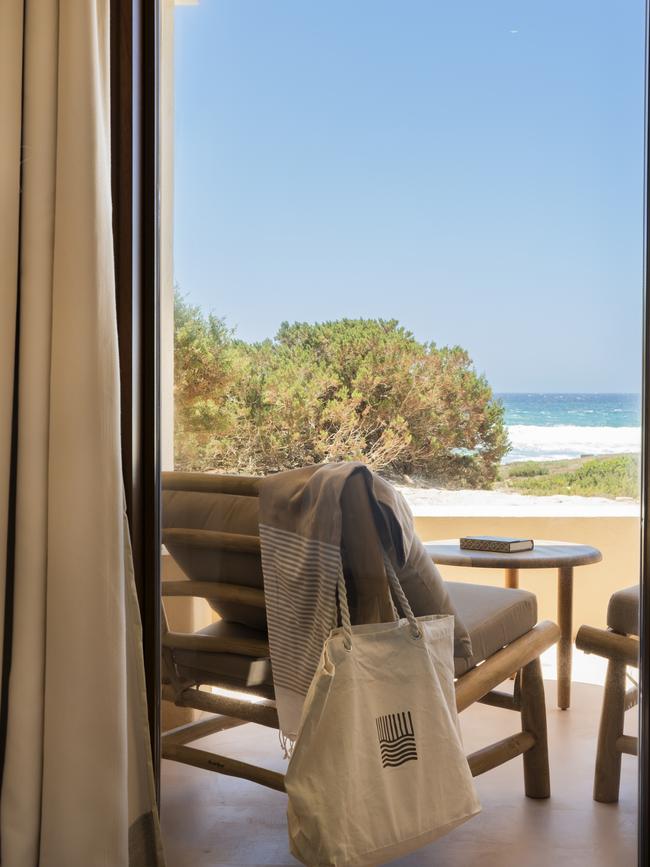The neon water is just the start of the discoveries on this Spanish island
As the water rolls into the golden cove, we dive under waves that sparkle and glisten around our skin. It is like swimming in diamonds.

Before we leave for Spain, my learned food-industry friend gives me a tip I take with a grain of salt. “Just go to the bars and restaurants on the beach,” he says. “I mean places actually on the beach. You’ll have the best time.”
I am sceptical because I’ve been to Spain many times and never eaten at a restaurant on a beach. In town squares, yes, and on street corners, in basement tapas bars, in people’s homes and even in service stations, but on the beach? I find this unlikely. Not only because seaside restaurants tend to be tourist traps but also because in faraway places like where we’re going – Formentera, the smallest of the Balearic islands off Spain’s east coast – I’m sure I’ll be hard pressed to find the right place.
It’s a case of having to swallow my scepticism, however, when we arrive at Dunas de Formentera, a new boutique hotel on the shores of this spectacular island located a half hour from Ibiza.

Not only is the hotel located on the dunes, as the name suggests, but from the pool I can see not one but two restaurants on the beach, one to our left, one to the right, plus several beachside bars. As well as seeing them, I can hear and smell them – the scent of frying fish, garlic and olive oil carried on the salty air along with the hum of joyful conversation, laughter and music. And so at once, all my holiday dreams are realised. Not only are we directly on one of the most extraordinary beaches in the world, I know that we will eat brilliantly too. Paradise, found.


Formentera is one of Spain’s untapped gems. Unlike its northern neighbour, Ibiza, an island that has so completely sold its soul to mass tourism that it is a better place to avoid than to visit, Formentera retains a romantic, old-world charm. The island is petite, only 20km long and 2km wide at its narrowest point, and distinguished by its flat, arid landscape and a rocky coastline met by iridescent seas. There’s nothing much here, with only one little township, Sant Francesc Xavier, notable for its distinctive, whitewashed cube-shaped church basking in the sun beside ancient olive trees.

Dunas de Formentera is positioned on a stretch of coastline called Cala Migjorn, on the island’s southern side. To walk into this hotel is to be immediately dazzled, not by the hotel itself (although it is stunning) but by the location and the environment. As the pine trees part in front of the hotel’s pool and restaurant, what is revealed is one of the world’s bluest and most crystalline stretches of water. “It’s just like the Caribbean,” one of the locals tells us proudly, adding that the water’s electric blue hue is due to local, UNESCO-protected seagrasses called Posidonia that reflect sunlight, creating the visual splendour.
We have to exercise self-control to even make it to our room before heading to the beach to dive in the dazzling sea. As the water rolls into the golden cove, we dive under waves that sparkle and glisten around our skin; the water is translucent even as we head deeper. I have never seen anything like it. It is like swimming in diamonds.
The beach, Playa de Migjorn, is bustling and bright without being crowded. There’s a small roped-off area for those who want to pay to shade under umbrellas but most lie about on the golden sand on towels, heading in and out of the water when the temperature reaches the low-30s. After swimming away the afternoon, we return to the hotel, walking a few metres off the sand to our room.

Opened in May, Dunas de Formentera brings a sense of international-level luxury to the island. It is said to have 45 suites, although the freestanding cube-shaped structures that house the suites are so sympathetic to the surrounds it’s hard to see them from sea level. Several times we walk past the hotel, entirely missing the beachfront entrance.
The property has been labelled Formentera’s “first regenerative hotel” because it relies solely on renewable energy, recycles waste water, uses local suppliers and participates in important marine rejuvenation programs. For the guest, these initiatives are mostly invisible. What’s key though is the sense of subtle luxury in each suite, conveyed through natural textures and finishings including stone floors and a colour palette the shade of the sand at the door. It even smells wonderful, powered by a local eucalyptus scent that permeates the room. As a bonus, our junior suite has a roomy balcony from which we sit and stare at the water for hours, totally bedazzled.

The hotel feels very much like part of a new wave of tourism in Europe that focuses on boutique rather than mass tourism. The prices are higher but what you get is the sort of magical local experience now almost irretrievably lost in places like Ibiza.
There’s a fabulous onsite restaurant and bar beside a pool shaded by native tress. About 5pm, when the heat of the day reaches its peak, it’s essential to sip cocktails. The infinity pool forms a wall of blue that blends into the sea beyond, and the white sun lounges give Greek island vibes, only the water is better here.

Then there are the local beachside restaurants to explore. At La Fragata, which dates to 1979, there’s seafood paella served at the table out of enormous cast-iron pans, while at Bichi Insula we eat like locals, ordering sea bass with roast Spanish potatoes. The food, so fresh, so authentic, is the best we eat in the Balearics by a mile. Not only that, these restaurants exude a sense of Spanish joy that constantly spills over. One day while at lunch at Bichi Insula, a flamenco band starts up and customers jump to their feet mid-meal to start dancing. The spirit of Spain is alive here.


Keep an eye out too for the chiringuitos, or beach kiosk-bars. Not far from Dunas, one of the world’s tiniest beach bars, Chiringuito Bartolo, is a beloved blue shack that
has operated on the beach since 1976 serving snacks and cocktails. It’s a quintessential island pitstop so I duly return with a note for my friend thanking him for the culinary tip. He was right. Now I am spreading the word.
Checklist
Getting there: Formentera is a 30-minute ferry from Ibiza, one of Spain’s biggest and busiest tourist ports. Ferries leave from Ibiza half-hourly in summer.


Stay: Dunas de Formentera is a 10-15 minute drive from Formentera’s La Savina port. You can hire a car in Ibiza and take it on the ferry to Formentera to get around the island, although this is being discouraged to try to reduce traffic. It’s better to catch cabs when needed. Redesigned by Mallorca-based Studio Antonio Obrado, the hotel has been converted from ageing serviced apartments to this boutique property; it really is a miraculous development. Dunas de Formentera is part of the Small Luxury Hotels of the World network (slh.com); rooms from 450 Euros ($750) inclusive of an à la carte breakfast of dishes including avo on toast, granola, juice, coffee and fruit.

Do: One of the Balearics’ most famous coves, the sandstone-edged Calo des Mort, is within walking distance of the hotel. See it, or stay put on Playa de Migjorn. In terms of sightseeing, the 1720s-built Church of Sant Francesc was once a fortress and is the pick of the sights.
Eat: Restaurante La Fragata is a vintage beachside restaurant; order the paella for its theatricality and deliciousness. We can’t stay away. We also enjoy the more upmarket Bichi Insula. Be sure also to try a chiringuito, there’s one outside the hotel (named KM11). Dunas also has a lovely alfresco restaurant called Caliu serving Mediterranean dishes.


To join the conversation, please log in. Don't have an account? Register
Join the conversation, you are commenting as Logout